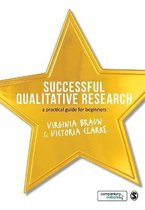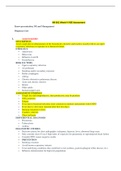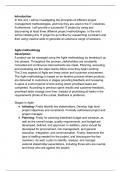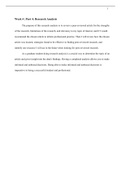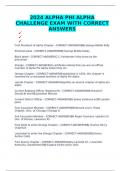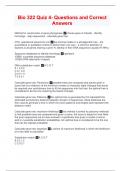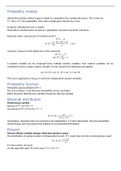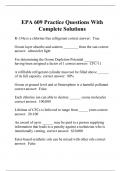Lecture 1:
Reflexivity: being aware of your role as an interviewer.
What is qualitative research?
1. Words are used as data. It is about the perception, the experience and the meanings of
the participants.
2. Seeks to understand and interpret meanings. We focus on understanding participants.
How does the participant experience or understand…?
3. Generates rich data: detailed complex information from participants. You use a smaller
sample than quantitative research. But the data we do obtain is more in-depth.
4. Theory generating is the aim of qualitative research. Qualitative research tends to seek
patterns, but also differences. Qualitative research is inductive.
Two kinds of qualitative research:
1. The Big Q: it is a paradigm (= a way of thinking/ a certain perspective). The
qualitative way of thinking is embedded in the whole research (= in sampling, data
analysis, results and so on). There is not one truth/reality and these are very closely
linked to the context in which it was generated. Important aspects of the qualitative
paradigm:
a. The 4 characteristics of qualitative research mentioned above.
b. A rejection of the natural sciences as a model of research.
c. The recognition that researchers bring their subjectivity into the research
process.
2. The Small Q: the use of qualitative techniques outside a qualitative paradigm. Some
techniques used in qualitative research are used as input for quantitative research. For
example, a scientist first has a focus group to inspire him for his survey for his
quantitative research; in this case qualitative methods are used as a ‘precursor’.
Qualitative can also be used alongside quantitative methods as a part of a ‘mixed
method’. Another way is when qualitative data is converted into numerical
representation and analyzed quantitatively.
The history of qualitative research in communication science. Communication science is a
relatively new study developed from psychology, sociology and political science. In these
studies, qualitative research is very popular.
1
,Qualitative sensibility: this refers to an orientation towards research that fits with the
qualitative paradigm. It is very important to have qualitative sensibility when you are a
qualitative researcher.
Ten fundamentals of qualitative research (so what are the differences with quantitative
research):
1. Qualitative research is about meaning, not about numbers. We want to understand
people. Because of a focus on knowledge as something that comes from and makes
sense within the context it was generated from, qualitative research does not assume
the ‘same’ accounts will always be generated every time by any researcher.
2. Qualitative research does not provide a single answer. There is more than one way to
make a meaning out of the data we analyze. There is no correct or incorrect answer.
Results can also differ very much between different participants and different times.
Qualitative researchers recognize that the data analyses we produce are like stories:
they are partial and subjective.
3. Qualitative research treats context as very important. Information and perceptions are
produced in particular contexts, by participants who come from and are located within
specific contexts. Qualitative research recognizes the subjectivity and bias of the data
we analyze and the analysis we produce.
4. Qualitative research can be experiential or critical. There are two fields in qualitative
research: experiential and critical.
a. Experiential qualitative research validates the meanings, views, perspectives
and experiences expressed in the data. The interpretations of the participants
are prioritized, rather than being used as a basis for analyzing something else.
In communication science experiential is the most often used field. The
concepts ‘verstehen’ and ‘getting inside people’s heads’ are very important.
Understand the point of view of the participant.
b. Critical qualitative research takes an interrogative stance towards meanings or
experiences expressed in the data and uses them to explore some other
phenomenon. The interpretation of the researcher is more important than the
interpretation of the participants. The critical field thus focuses on the
interpretation of the researcher. The researcher interprets what the participants
say and they are critical about this; they search for hidden information (= for
example hidden differences between cultures or sexes).
2
, 5. Qualitative research is underpinned by ontological assumptions. Ontology is a way of
thinking about reality. Ontology determines whether or not we think reality exists
entirely separate from human practices and understandings or whether we think it
cannot be separated from human practices. There are three types of ontology:
a. Realism: assumes a knowable world, which is comprehensible through
research – that the truth is ‘out there’ and can be accessed by the appropriate
application of research techniques (= quantitative research).
b. Relativism: assumes that there are multiple constructed realities and we can
never get beyond these constructions. What is real and true differs across time
and context.
c. Critical realism: this perception is most common in qualitative research. It
assumes that there is a real and knowable world, which sits behind the
subjective and socially-located knowledge a researcher can access. Because
knowledge is viewed as socially influences, it is thought to reflect a separate
reality that we can only partially access. Reality differs between people, but
there are always things people have in common.
6. Qualitative research underpinned by epistemological assumptions. Epistemology is
about the nature of knowledge. Where does knowledge come from? There are three
perspectives on this:
a. Positivism: there is a straightforward relationship between the world and our
perception of it. There are observable facts. Objective collection and analysis
of data is important. The scientific method is important to obtain valid
knowledge.
b. Constructionism: what we know of the world is constructed through systems of
meaning. What we know of the world is dependent on our perspectives.
Knowledge is a product of how we come to understand it. There are therefore
multiple truths.
c. Contextualism: is in between these extremes. The reality is local and
dependent on the context. Knowledge emerges from contexts.
7. Qualitative research involves a qualitative methodology. A methodology refers to the
framework within which our research is conducted. It can be understood as a theory of
how research needs to proceed, to produce valid knowledge about the psychological
and social world.
8. Qualitative research uses all sorts of data; participants, social media accounts, books
and so on. Data is useful for qualitative research when it is ‘rich’ and it must be linked
to the purpose of your research. It must be linked to your research question.
3

